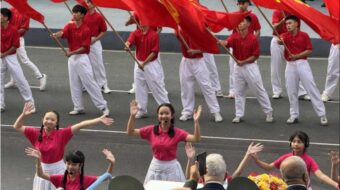Military alliances are always sold as things that produce security. In practice they tend to do the opposite.
Thus, Germany formed the Triple Alliance with Italy and the Austro-Hungarian Empire to counter the enmity of France following the Franco-Prussian War. In response, France, England and Russia formed the Triple Entente. The outcome was World War I.
In 1949, the United States and Britain led the campaign to form the North Atlantic Treaty Organization (NATO) to deter a supposed Soviet attack on Western Europe. In response, the Soviets formed the Warsaw Pact. What the world got was not security but the Cold War, dozens of brushfire conflicts across the globe, and enough nuclear weapons to destroy the earth a dozen times over.
NATO lives on
The Cold War may be over, but you would never know it from NATO’s April meeting in Bucharest. The alliance approved membership for Croatia and Albania, and only French and German opposition prevented the Bush administration from adding the former Soviet republics of Ukraine and Georgia.
“NATO,” President Bush told the gathering, “is no longer a static alliance focused on defending Europe from a Soviet tank invasion. It is now an expeditionary alliance that is sending its forces across the world to help secure a future of freedom and peace for millions.”
NATO will soon begin deploying anti-ballistic missile (ABM) systems in Poland and the Czech Republic that are supposedly aimed at Iran, but which the Russians charge are really targeted at them. The alliance has encircled Russia with allies and bases, is increasingly sidelining the United Nations, has added troops to Afghanistan, and is preparing to open shop in the Pacific Basin.
But politics is much like physics: for every reaction there is an equal and opposite reaction.
Shanghai strikes back
In this case the reaction is the Shanghai Cooperation Organization (SCO), an organization that embraces one quarter of the world’s population, from Eastern Europe to North Asia, from the Arctic to the vast steppes and mountain ranges of Central Asia. Formed in 2001, its members include China, Russia, Kazakhstan, Kyrgyzstan, Tajikistan, and Uzbekistan.
The SCO is, in the words of a Financial Times editorial, “everything that Richard Nixon and Henry Kissinger – who sought to keep Russia and China apart – tried to prevent.”
According to Chinese Foreign Minister Yeng Jiechi, last August’s SCO meeting in the Kyrgyz capital of Bishkek, prioritized “mapping out Sino-Russian ties and upgrading bilateral strategic coordination.” The two nations also agreed “to join forces to tackle other major security issues, in a concerted effort to safeguard the strategic interests of both countries.”
It is useful to remember that it was less than 40 years ago that Chinese and Soviet troops clashed across the Ussuri River north of Vladivostok.
According to China’s People’s Daily, SCO discussions included strengthening the UN and “the common challenge facing the two countries, emanating out of the U.S. plans to deploy the missile-defense plans targeting Europe and the East.”
China is deeply concerned about the Bush administration’s anti-ballistic missile system (ABM) which could cancel out Beijing’s modest Intercontinental Ballistic Missile (ICBM) force. This past May 23, Russian President Dmitry Medvedev and Chinese President Hu Jintao issued a joint statement condemning the ABM as a threat to “strategic balance and stability.”
The Bishkek summit adopted a declaration that took direct aim at the Bush administration’s foreign policy, including condemning “unilateralism” and “double standards,” supporting “multilateralism,” and “strict observance of international law,” and underlining the importance of the UN.
Is the Shanghai Cooperation Organization evolving into a political alliance with a strong military dimension, like NATO? Not yet, but its member states have carried out joint “anti-terrorist” maneuvers, and the organization is closely tied to the Collective Security Treaty Organization (CSTO).
The un-NATO
The Collective Security Treaty Organization, established in 2002, includes Russia, Armenia, Belarus, Tajikistan, Kazakhstan, Kyrgyzstan and Uzbekistan. It is a full-blown military alliance whose members have pledged to come to one another’s support in case of an attack. It is currently developing a rapid-reaction force similar to the one being built by NATO.
M. K. Bhadrakumar, a former career diplomat who served as India’s ambassador to Uzbekistan, argues that that the two organizations may eventually merge. “The SCO may focus on the range of so-called ‘new threats’ [terrorism] rather than on the conventional form of military threats, while the CSTO would maintain a common air-defense system, training of military personnel, arms procurement, etc.”
In the same week that the SCO met in Bishkek, the Russians announced their response to NATO’s ABM system: a resumption of strategic air patrols, improving Moscow’s anti-missile system, modernizing the Topol-M ICBM, and constructing new missile firing submarines.
Next stop: Central Asia
To counter the Shanghai Cooperation Organization’s growing influence — the organization now has official observer status at the UN, and a working relationship with the Association of South East Asian Nations — the United States launched a “Great Central Asia” strategy to try and drive a wedge between Central Asian nations and Russia, and to woo India by playing on New Delhi’s apprehension of China’s growing power.
But, according to Bhadrakumar, the Central Asian part of the strategy is not likely to be very successful, with the possible exception of Turkmenistan. With the United States deeply mired in Iraq and Afghanistan, he says, “U.S. stock is very low” in the region.
Washington may have more success with India, but New Delhi is clearly of two minds about the SCO. On one hand, many Indians are nervous about the growing power of China. On the other, India desperately needs the energy resources of Central Asia.
India will probably chart a middle course, keeping itself free of political alliances, but making sure it doesn’t do anything that might disrupt the flow of gas and oil to its growing industries. For instance, New Delhi sharply rejected the Bush administration’s efforts to halt a pipeline deal between India and Iran.
Whether the SCO will turn into an eastern NATO is by no means clear, but the economic side of the alliance is solidly grounded in self-interest.
NATO in trouble
NATO, on the other hand, is an alliance in trouble. While the organization has agreed to help bail the United States out of the Afghan quagmire, member nations are hardly enthusiastic about the war. At the April meeting the U.S. plea for more troops turned up 700 French soldiers. As Anatol Lieven, a professor of war studies at King’s College London, points out, this comes to one for every 400 square miles of Afghanistan.
NATO did back the ABM deployment, but no one besides Washington is breaking out the champagne. Some 70 percent of the Czech public opposes it, and the Poles are using the issue to blackmail the United States into modernizing its military. As one U.S. policy analyst cynically remarked to Financial Times columnist Gideon Rachman, the ABM is “a system that won’t work, against a threat that doesn’t exist, paid for by money we don’t have.”
The U.S. ABM program has run up a bill of over $100 billion and, according to a recent Government Accounting Office report, it hasn’t been successfully tested with “sufficient realism.”
Translation: the tests are rigged.
If NATO falls apart, and the SCO never develops into a military alliance, history suggests that we will probably all be better off. Military alliances have a way of making people miscalculate, and miscalculating in a world filled with nuclear weapons is a dangerously bad idea.
Conn Hallinan is a Foreign Policy In Focus columnist. This article is reprinted from the FPIF web site with permission of the author.










